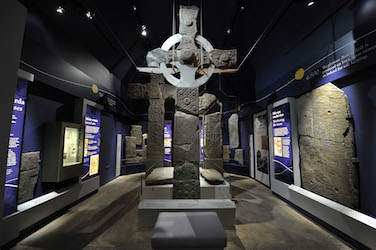Added to the perennial challenges of balancing lighting for display with requirements to minimise light exposure to protect objects from degradation, we now are increasingly pressed to find solutions to reduce lighting energy requirement and maintenance costs.
LEGAL CHANGES
We are now starting to feel the effects of the EU’s Ecodesign Directive for energy-related products (Directive 2009/125/EC) that has outlawed the manufacture and placing on the market of the humble incandescent lamp. From September last year, the low-voltage reflector lamp, the mainstay of display lighting for the last 30 years, has had to conform to stricter efficiency targets, with the result that the range of lamps has been massively reduced. Among the casualties is the ENL, which is specific to many fibre-optic case lighting solutions. Currently we are awaiting the EU energy directorate’s deliberations on other lamps, including mains-voltage tungsten halogen. The choices seem to be banning these in either 2016 or 2018.

COLOUR COSTS
In parallel with this, we are seeing developments in LED lighting technology. There are now some products that are fit for use in museums, providing a good colour quality and appearance. These still remain the exceptional, often niche products, with the vast majority of LED spotlights and lamp replacements being of poor colour quality, and many of dubious longevity. As may be expected, niche quality products tend to have price tags that reflect their rarity.
The higher quality of light appearance and colour rendering also has a price when it comes to efficiency. Providing a full colour spectrum of light necessitates the use of less efficient phosphors and more of them reducing direct light from the LED. Further problems with optical control can reduce the efficiency of some products almost to the same level as the best of the low-voltage tungsten halogen lamps they are replacing. At best, you are only doubling the efficiency – a far cry from the six or eight times efficiency claimed by most LED suppliers.
LONGEVITY
In terms of maintenance, the LED light source itself has a commendably long life when in a suitably engineered fitting; however expectations of zero maintenance are deeply flawed. Unless specific regular cleaning of the fitting, optic and heat sinks is undertaken, light levels will drop precipitately over time and failures due to overheating caused by dirty or blocked heat sinks and cooling systems will become prevalent. While often not meticulous, a degree of cleaning necessarily takes place during the re-lamping of conventional fittings. Certainly with reflector lamps, you are replacing the reflector, saving the need to clean it.
Overall, the true costs of the changeover to LED are much higher than is normally expected, and payback calculations need to be looked at with specific consideration of the museum environment and the high lighting quality expected. The other factor is that, even with expected LED life of 50,000 hours, you will be committing yourself to a wholesale re-lighting with new fittings in around 15 years. There is little prospect of re-using fittings purchased now in 15 years’ time, LED development and product development means that things will be different. In the museums world, 15 years is a relatively short life for a lighting scheme. Take a look around most museums – large or small – and it is far from uncommon to see lighting that is 30 or even more years old and still functioning.
ADVANTAGES
There are some benefits to the new technologies. Very small low-powered lights are possible, allowing discrete lighting of detail. Overall, the lower power required for lighting will also reduce cooling energy costs, though the increase in heating energy required in winter may cancel out much or all of these savings in non-cooled buildings. Opportunities for controlled and dynamic lighting come at a far lower increase in cost compared to what we are used to with conventional lighting. Variations in colour to enhance specific displays are also much easier. These may produce improved display appearance for many objects that lose colour appearance in the warm light of dimmed tungsten halogen.
LIGHT CONTROL
Interest in daylight as a principal light source for display has also increased, partly in response to reducing lighting energy costs. This has to be a good thing; however it does need a lot more care and effort in monitoring light exposure. It has always seemed strange that close and detailed monitoring of temperature and humidity seems to be de rigueur in most institutions, while recording and monitoring of light levels is seen as exceptional and onerous. This is despite the importance of keeping on top of light degradation, which affects almost every object in most collections. As it is now universally understood that it is light exposure rather than lighting at any specific light level which causes degradation, lighting control and monitoring must be taken more seriously. Using lighting controls to dim down and switch off lighting when it is not required can produce far higher energy savings than wholesale and expensive technology change. Sometimes this is just a matter of reconsidering existing control settings or a more rigorous management approach to switching lighting by staff and warders.
There is no question that finding ways and means to reduce energy use in museums is an urgent and present task. Not the least is the benefit of saving money from energy bills that can be better spent on other aspects of collection care. Lighting definitely is a major part of that task and savings can be achieved without any loss of lighting quality, even improving it, in fact, if it is done carefully and thoughtfully. However, there is ample scope for getting it wrong, wasting money on poor quality solutions, reducing the quality of the visitor experience and even risking damage to objects in the collection. Sadly, there is no simple formula and no easy swap of one lamp or fitting for another. A careful strategic approach, tailored to the specific situation of each museum and their collections, is necessary to achieve satisfactory results in a planned, cost-effective way within a manageable budget.
ABOUT THE AUTHOR
Kevan Shaw BSc, C.Eng MILP, MSLL, IALD, is Design Director of KSLD and was voted Lighting Designer of the Year at the 2013 LUX Awards.
Back to top




